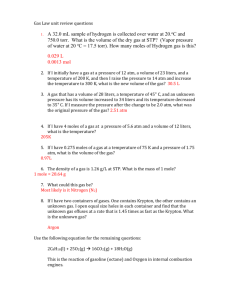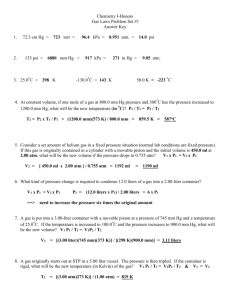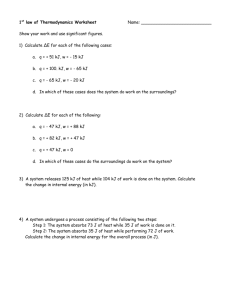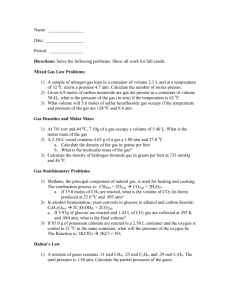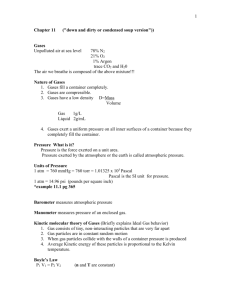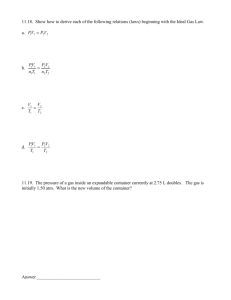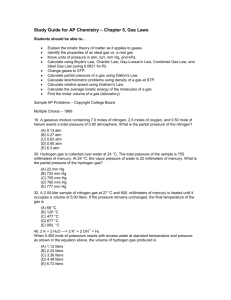Retake Criteria for Unit 9 Gases Assessment 2015
advertisement
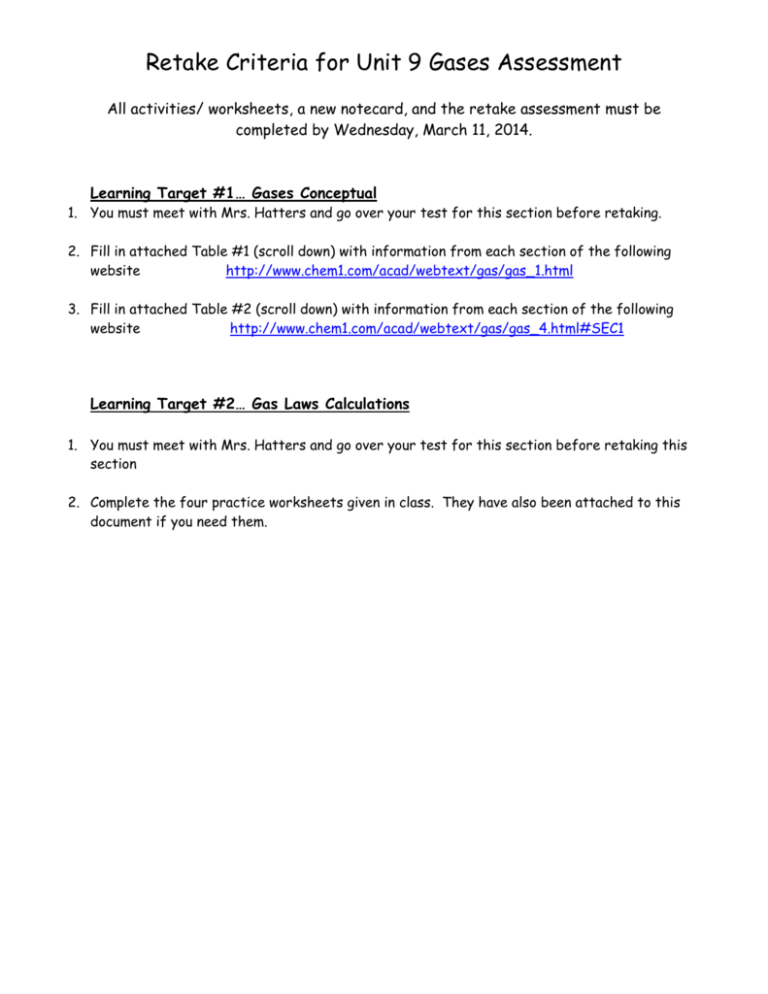
Retake Criteria for Unit 9 Gases Assessment All activities/ worksheets, a new notecard, and the retake assessment must be completed by Wednesday, March 11, 2014. Learning Target #1… Gases Conceptual 1. You must meet with Mrs. Hatters and go over your test for this section before retaking. 2. Fill in attached Table #1 (scroll down) with information from each section of the following website http://www.chem1.com/acad/webtext/gas/gas_1.html 3. Fill in attached Table #2 (scroll down) with information from each section of the following website http://www.chem1.com/acad/webtext/gas/gas_4.html#SEC1 Learning Target #2… Gas Laws Calculations 1. You must meet with Mrs. Hatters and go over your test for this section before retaking this section 2. Complete the four practice worksheets given in class. They have also been attached to this document if you need them. Unit 9 Gases Retake Criteria Learning Target #1… Gases Conceptual TABLE #1 Fill in the following table with information from each section of the following website http://www.chem1.com/acad/webtext/gas/gas_1.html What’s special about gases? The pressure of a gas Absolute temperature The volume occupied by a gas 4. State the three major properties of gases that distinguish them from the other phases of matter. 5. Define pressure, and explain why a gas exerts pressure on the walls of a container 6. Why must the temperature and pressure be specified when reporting the volume of a gas? Unit 9 Gases Retake Criteria Learning Target #1… Gases Conceptual TABLE #2 Fill in the following table with information from each section of the following website http://www.chem1.com/acad/webtext/gas/gas_4.html#SEC1 Molecules in Motion The basic ideas Kinetic interpretation of pressure Kinetic interpretation of temperature Kinetic interpretation of Boyle’s law Kinetic interpretation of Charles’ law Chemistry Unit 9 Combined Gas laws WS 2 Name ___________________ 1. The pressure of a system with a volume of 14.3 L is 3.61 atm. If the pressure is suddenly decreased to 1.94 atm, what would the volume be? 2. What was the initial volume when the temperature was 65°C if the final volume was 0.85 L with a temperature of 84°C? 3. What is the volume of a collapsible container that originally had a volume of 6.0 L if the pressure changed from 0.86 atms to 105.4 kPa? 4. If 4.41 L of gas are collected at a pressure of 0.254 atm, what volume will the same gas occupy at standard pressure if the temperature was originally at 93.6°C and was decreased by 45.9°C? 5. What was the initial temperature, in °C, of a gas in a sealed container that has a final volume of 6500 mL at standard temperature if the initial volume was 3100 mL and the pressure was kept constant? 6. A sample of neon gas occupies a volume of 60.0 mL at 36°C. What volume will this gas occupy at standard temperature? 7. What size container would be needed to contain 75 g of Chlorine gas at STP? 8. What is the new pressure (in atm) of a system with a volume of 925 mL and a temperature of 125 °C, if the old pressure was 730 mm Hg when the volume was 975 mL and the temperature was 95°C? Chemistry Ideal Gas Law WS Solve the following problems using the ideal gas law: Name _______________ 1) How many moles of gas does it take to occupy 120 liters at a pressure of 2.3 atmospheres and a temperature of 340 K? 2) If I have a 50 liter container that holds 4.5 moles of gas at a temperature of 200°C, what is the pressure (in atm) inside the container? 3) It is not safe to put aerosol canisters in a campfire, because the pressure inside the canisters gets very high and they can explode. If I have a 1.0 liter canister that holds 2 moles of gas, and the campfire temperature is 1400°C, what is the pressure inside the canister? 4) How many moles of gas are in a 30 liter scuba canister if the temperature of the canister is 300 K and the pressure is 200 kPas? 5) I have a balloon that can hold 100 liters of air. If I blow up this balloon with 3 moles of oxygen gas at standard pressure, what is the temperature, in °C, of the balloon? Chemistry Unit 9 Gas Unit Review Name ___________________ 1. The pressure of a system with a volume of 4.3 L is 3.61 atm. If the pressure is suddenly decreased to 2.94 atm, what would the volume be? 2. What is the new pressure (in atm) of a system with a volume of1925 mL and a temperature of 105 °C, if the old pressure was 760 mm Hg when the volume was 1975 mL and the temperature was 85°C? 3. What size container would be needed to contain 45 g of Chlorine gas at STP? 4. What was the initial temperature (in °C) when the volume was 6.50 L if the final volume was 6.85 L with a temperature of 74°C? 5. A sample of neon gas occupies a volume of 260.0 mL at 136°C. What volume will this gas occupy at standard temperature? 6. If 0.41 L of gas are collected at a pressure of 0.54 atm, what volume will the same gas occupy at standard pressure if the temperature was originally at 73.6°C and was decreased by 25.9°C? 7. What was the initial temperature, in °C, of a gas in a sealed container that has a final volume of 650 mL at standard temperature if the initial volume was 310 mL and the pressure was kept constant? 8. If an excess amount of magnesium will react with 6.88 L of oxygen gas, how many grams of magnesium oxide should have been produced? 2 Mg + O2 2 MgO Chemistry Unit 9 – Gases Study Guide What’s going to be on the test?? THE LEARNING TARGETS! Our learning targets for this unit will be “I can…” Properties of Gases (Section 14.1) 1. Convert between the pressure units; atm, kPa, mm Hg a.) Fill out the table below atm kPa 101.3 mmHg 568 3.7 378 904 2. Convert using the temperature scales; Kelvin, Celsius b.) Fill in the table below C 5 K 725 -56 903 Combined Gas Law (Section 14.2) 3. Calculate variables of a gas using the combined gas law c.) A gas has a volume of 8ml and a temperature of 16 ºC and is at a pressure of 1.6atm. The volume increases to 20mL and the temperature stays the same. What is the new pressure? d.) A gas has a volume of 800.0L at -23.00 ºC and 300mmHg. What would the volume of the gas be if the conditions were changed to 227.0 ºC and 0.89atm? e.) A 3mL bubble is at the bottom of lake Michigan at a pressure of 50atm. The temperature way down there is 5 ºC. Just before the bubble reaches the top of the water the pressure is 760.3mmHg and the water temperature is 30 ºC. What is the new volume of the bubble? f.) A gas is in a ridged metal 300mL tank. The temperature is 35 ºC, the pressure is 17 atm. If no gas is added to the tank and the pressure increases to 25atm what must the new temperature be? Ideal Gas Law (Section 14.3) 4. Calculate variables of a gas using the ideal gas law g.) Manipulate the following equation to solve for each of the variables within the equation. PV=nRT P= V= n= R= T= h.) If I have an unknown quantity of gas at a pressure of 1.2 atm, a volume of 31 liters, and a temperature of 87 0C, how many moles of gas do I have? i.) If I contain 3 moles of gas in a container with a volume of 60 liters and at a temperature of 400 K, what is the pressure inside the container? j.) If I have 7.7 moles of gas at a pressure of 0.09 atm and at a temperature of 56 0C, what is the volume of the container that the gas is in? 5. Use stoichiometry and molar volume to determine unknown quantities of gases Ethylene burns in oxygen to form carbon dioxide and water vapor: C2H4(g) + 3 O2(g) 2 CO2(g) + 2 H2O(g) k.) How many moles of ethylene are needed to produce 3 liters of water? l.) 1.5 liters of ethylene reacts with excess oxygen. How many liters of water are produced? Hydrogen gas and nitrogen gas combine to form ammonia. 3 H2 + 2 N2 2 NH3 m.) 6 liters of hydrogen reacts with excess nitrogen gas. How many liters of ammonia are formed? n.) How many grams of ammonia can be formed using 7.8 liters of nitrogen gas?
